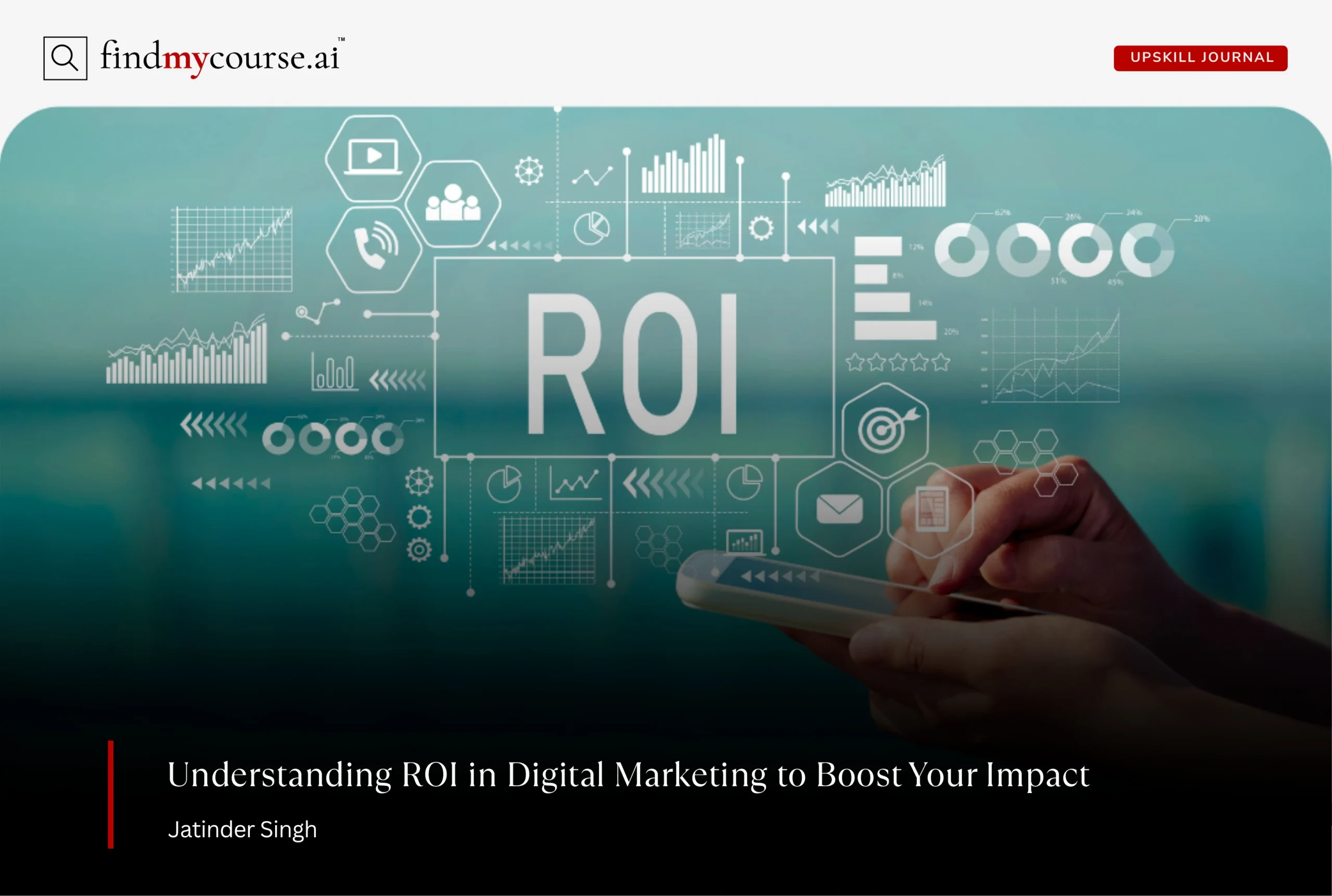In today’s fast-moving digital landscape, every marketing dollar must prove its worth. Businesses aren’t just chasing clicks—they’re demanding clarity on what truly drives growth. That’s why measuring ROI in digital marketing has become one of the most essential skills for modern marketers and business leaders alike. Far beyond a simple percentage, ROI also reveals how effectively your marketing investments generate real business results. When measured correctly, it uncovers which campaigns deliver the highest impact, where budgets can be optimized, and how strategy translates into revenue.
Understanding and measuring ROI in digital marketing empowers you to make data-driven decisions with confidence. Whether you’re a business owner refining budgets or a marketer eager to upskill in analytics, mastering this process transforms marketing from a guessing game into a predictable growth engine.
What Is ROI in Digital Marketing?
Before diving into the math, let’s clarify what ROI in digital marketing actually means. ROI—Return on Investment—is a measure of how much revenue you generate for every dollar spent on marketing. So, in simple terms, it answers one big question: “Is this marketing activity profitable?”
The basic formula for calculating ROI is:
ROI = (Net Profit ÷ Marketing Cost) × 100
For example, if you spend $1,000 on a campaign and earn $4,000 in sales, your ROI is 300%. That means for every dollar you invested, you gained three more.
However, in digital marketing, ROI isn’t always about direct revenue. Some campaigns aim to build awareness, generate leads, or nurture relationships. In such cases, ROI can also include metrics like cost per lead (CPL), customer lifetime value (CLV), or engagement rates that connect to long-term profit.
How to Measure ROI in Digital Marketing Step-by-Step
Measuring ROI in digital marketing becomes much easier when you break it into manageable stages. The key is to connect your marketing activity to real business outcomes. Here’s how to do it effectively:
Step 1 – Define Clear Goals
Start with clarity and intention. What do you want your campaign to achieve—more sales, new leads, greater brand visibility, or higher website traffic? Each objective shapes how you measure success. For instance, an e-commerce brand may focus on direct revenue, while a B2B company might prioritize lead generation. The clearer your goals, the easier it is to align metrics that truly matter.
Step 2 – Identify the Right Metrics
Once your goals are set, choose metrics that reflect progress. Common KPIs include:
- Sales revenue
- Conversion rate
- Cost per acquisition (CPA)
- Customer lifetime value (CLV)
- Average order value (AOV)
Each of these metrics tells a different part of your ROI story. Thus, the more precise and measurable they are, the more accurately you can assess the real impact of your marketing efforts.
Step 3 – Track Data Across All Channels
Modern marketing happens everywhere—social media, email, search engines, and beyond. To see the full picture, track results across all platforms using tools like Google Analytics 4, HubSpot, or Meta Ads Manager. Integrating these data sources ensures that you don’t just look at isolated numbers but understand how different channels work together to drive results.
Step 4 – Calculate ROI Accurately
Now, it’s time to quantify success. Use the classic formula:
ROI = (Net Profit ÷ Marketing Cost) × 100
Be sure to include all associated costs—ad spend, creative development, software, and team hours. For example, if you spend $5,000 on a campaign and generate $20,000 in revenue, your ROI is 300%. This means every dollar invested earned you three in return—a clear indicator of performance.
Step 5 – Analyze and Optimize Continuously
The real magic happens after the calculation. Analyze your results to uncover patterns: Which campaigns exceeded expectations? Which ones need refinement? Use A/B testing, audience segmentation, and retargeting to improve future outcomes. Remember, measuring ROI isn’t a one-time task—it’s an ongoing process of learning and optimizing to get better with each campaign.
Beyond Numbers: Understanding the True Value of Digital Marketing ROI
While formulas give you numbers, the real power of ROI in digital marketing lies in insights. Not every win can be quantified immediately—some benefits unfold over time. Brand credibility, customer trust, and engagement all contribute to long-term returns.
For instance, a social media campaign may not yield instant sales, but it can build brand recognition that eventually leads to customer loyalty. Measuring ROI holistically helps balance short-term profit with long-term growth.
Moreover, AI-driven analytics tools in 2025 make it easier to attribute value across complex customer journeys. These tools map how each interaction—an ad click, email open, or blog read—contributes to final conversions.
Key Tip:
Combine quantitative data (revenue, conversions) with qualitative metrics (brand sentiment, engagement quality) to see the full picture of your marketing performance.
Best Tools to Measure and Improve Digital Marketing ROI
Technology is your best ally in managing and optimizing ROI. Here are some top tools professionals rely on in 2025:
| Tool | Key Function | Description |
| Google Analytics 4 (GA4) | Cross-platform tracking | Tracks user behavior across web and apps with real-time and predictive insights. |
| HubSpot | Marketing automation | Merges campaign automation with ROI and lead analytics in one platform. |
| Supermetrics | Data reporting | Pulls and consolidates data from multiple channels for easy ROI tracking. |
| Tableau | Data visualization | Converts marketing data into clear, interactive dashboards for reporting. |
| Hootsuite Impact | Social media analytics | Tracks social ROI, engagement, and conversions to guide content strategy. |
These platforms not only simplify tracking but also help forecast performance trends, making your future campaigns more data-driven and profitable.
Common Challenges in Measuring ROI in Digital Marketing
Despite advanced tools, marketers still face hurdles in measuring ROI accurately. Let’s address the most common challenges and how to overcome them:
1. Multi-Touch Attribution
Customers rarely convert after a single interaction. Attribution models—such as first-click, last-click, or data-driven attribution—help determine which touchpoints deserve credit. Using data-driven models gives a more realistic understanding of ROI.
2. Tracking Offline Conversions
If your digital campaigns drive phone calls, store visits, or offline purchases, connecting those to online activity can be tricky. Solutions include CRM integrations and unique tracking codes to link digital actions with offline outcomes.
3. Measuring Non-Financial Metrics
Brand awareness and engagement don’t have direct revenue links but still impact ROI over time. Use proxy metrics like engagement rates, share of voice, and customer retention to demonstrate value.
4. Inconsistent Data Tracking
Without unified tracking systems, data silos can distort your ROI calculations. Ensure all marketing platforms feed into a central analytics dashboard for accurate results.
Conclusion
Measuring ROI in digital marketing is not just about crunching numbers—it’s about unlocking insights that fuel smarter decisions and sustainable growth. In 2025, the most successful marketers are those who blend creativity with analytical precision, continually learning and refining their approach.
By defining clear goals, tracking the right metrics, and interpreting results with a long-term lens, you can turn marketing performance into business power. The ability to measure and improve ROI isn’t just a professional skill—it’s your compass in a digital-first economy. And if you ever need help along the way, our AI assistant is here to guide you with data-driven insights and practical advice.


